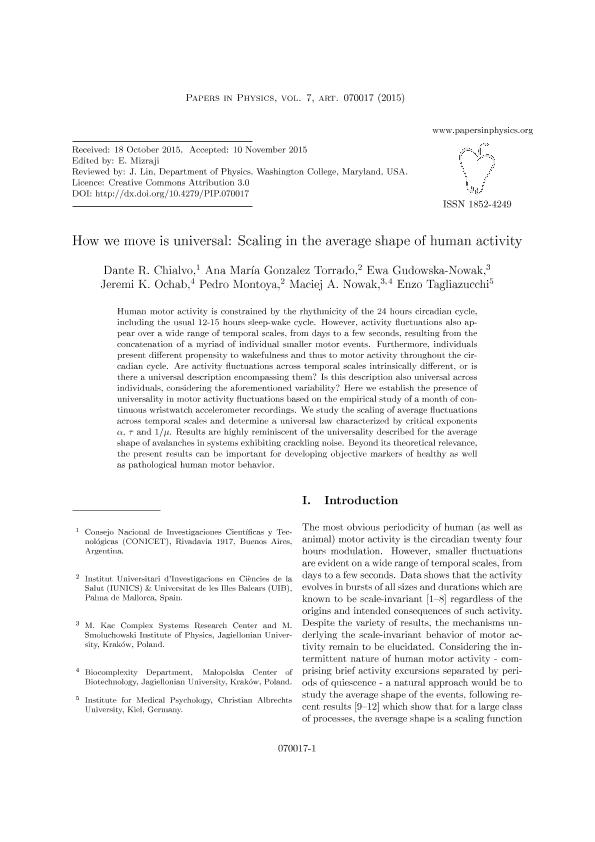Mostrar el registro sencillo del ítem
dc.contributor.author
Chialvo, Dante Renato

dc.contributor.author
Gonzalez Torrado, Ana Maria
dc.contributor.author
Gudowska Nowak, Ewa
dc.contributor.author
Ochab, Jeremi K.
dc.contributor.author
Montoya, Pedro
dc.contributor.author
Nowak, Maciej A.
dc.contributor.author
Tagliazucchi, Enzo
dc.date.available
2017-03-03T21:04:16Z
dc.date.issued
2015
dc.identifier.citation
Chialvo, Dante Renato; Gonzalez Torrado, Ana Maria; Gudowska Nowak, Ewa; Ochab, Jeremi K.; Montoya, Pedro; et al.; How we move is universal: scaling in the average shape of human activity; Instituto de Física de Líquidos y Sistemas Biológicos; Papers in Physics; 7; 2; -1-2015; 1-7; 070017
dc.identifier.issn
1852-4249
dc.identifier.uri
http://hdl.handle.net/11336/13526
dc.description.abstract
Human motor activity is constrained by the rhythmicity of the 24 hours circadian cycle, including the usual 12-15 hours sleep-wake cycle. However, activity fluctuations also appear over a wide range of temporal scales, from days to a few seconds, resulting from the concatenation of a myriad of individual smaller motor events. Furthermore, individuals present different propensity to wakefulness and thus to motor activity throughout the circadian cycle. Are activity fluctuations across temporal scales intrinsically different, or is there a universal description encompassing them? Is this description also universal across individuals, considering the aforementioned variability? Here we establish the presence of universality in motor activity fluctuations based on the empirical study of a month of continuous wristwatch accelerometer recordings. We study the scaling of average fluctuations across temporal scales and determine a universal law characterized by critical exponents α, τ and 1/µ. Results are highly reminiscent of the universality described for the average shape of avalanches in systems exhibiting crackling noise. Beyond its theoretical relevance, the present results can be important for developing objective markers of healthy as well as pathological human motor behavior.
dc.format
application/pdf
dc.language.iso
eng
dc.publisher
Instituto de Física de Líquidos y Sistemas Biológicos
dc.rights
info:eu-repo/semantics/openAccess
dc.rights.uri
https://creativecommons.org/licenses/by-nc-sa/2.5/ar/
dc.subject
Circadian Cycle
dc.subject
Motor Activity
dc.subject.classification
Otras Ciencias Físicas

dc.subject.classification
Ciencias Físicas

dc.subject.classification
CIENCIAS NATURALES Y EXACTAS

dc.title
How we move is universal: scaling in the average shape of human activity
dc.type
info:eu-repo/semantics/article
dc.type
info:ar-repo/semantics/artículo
dc.type
info:eu-repo/semantics/publishedVersion
dc.date.updated
2017-02-23T13:57:10Z
dc.journal.volume
7
dc.journal.number
2
dc.journal.pagination
1-7; 070017
dc.journal.pais
Argentina

dc.journal.ciudad
La PLata
dc.description.fil
Fil: Chialvo, Dante Renato. Consejo Nacional de Investigaciones Científicas y Técnicas; Argentina
dc.description.fil
Fil: Gonzalez Torrado, Ana Maria. Universidad de las Islas Baleares; España
dc.description.fil
Fil: Gudowska Nowak, Ewa. Jagiellonian University; Polonia
dc.description.fil
Fil: Ochab, Jeremi K.. Jagiellonian University; Polonia
dc.description.fil
Fil: Montoya, Pedro. Universidad de las Islas Baleares; España
dc.description.fil
Fil: Nowak, Maciej A.. Jagiellonian University; Polonia
dc.description.fil
Fil: Tagliazucchi, Enzo. Christian Albrechts University; Alemania
dc.journal.title
Papers in Physics
dc.relation.alternativeid
info:eu-repo/semantics/altIdentifier/doi/http://dx.doi.org/10.4279/PIP.070017
dc.relation.alternativeid
info:eu-repo/semantics/altIdentifier/url/http://www.papersinphysics.org/index.php/papersinphysics/article/view/275
dc.relation.alternativeid
info:eu-repo/semantics/altIdentifier/url/https://arxiv.org/abs/1506.06717
dc.relation.alternativeid
info:eu-repo/semantics/altIdentifier/url/http://ref.scielo.org/x7qrqh
Archivos asociados
